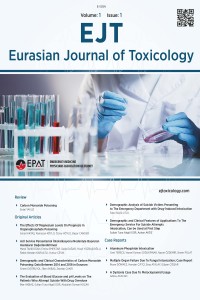Abstract
A 35-year-old
female patient was admitted to our hospital with organ failure due to excessive
consumption of wild mushrooms. She had a medical history of previous
tuberculosis and, in accordance with it, a destructed lung. Hepatorenal
syndrome and encephalopathy clinics were established. The patient's clinical
findings related to fungal intoxication declined with penicillin G and
supportive fluid electrolyte treatment, however, the patient died from ARDS due
to her destructed lung. Fungal intoxication may be
asymptomatic throughout the incubation period. Health care professionals should
consider that fungal intoxication may also occur in patients admitted with
asymptomatic symptoms due to seasonal conditions and nutritional habits.
Keywords
References
- Reference 1. Ergüven, M., Çakı, S., & Deveci, M.. Mantar zehirlenmesi: 28 vakanın değerlendirilmesi. Çocuk Sağlığı ve Hastalıkları Dergisi.2004. 47(4), 249-53.
- Reference 2. Sonmez, B. Demographic and Clinical Characteristics of Mushroom Poisonings Presenting to Emergency Department. Journal of Clinical and Analytical Medicine. 2014. 6(100), 469-472.
- Reference 3. Chew, K. S., Mohidin, M. A., Ahmad, M. Z., Kamauzaman, T. H. N. T., & Mohamad, N. Early onset muscarinic manifestations after wild mushroom ingestion. International journal of emergency medicine. 2008. 1(3), 205-208.
- Reference 4. Kintziger, K. W., Mulay, P., Watkins, S., Schauben, J., Weisman, R., Lewis-Younger, C., et all. Wild mushroom exposures in Florida, 2003–2007. Public Health Reports. 2011. 126(6), 844-852.
- Reference 5. Ye, Y., & Liu, Z.. Management of Amanita phalloides poisoning: A literature review and update. Journal of critical care. 2018.Aug;46:17-22.
- Reference 6. Magdalan, J., Piotrowska, A., GomuŁkiewicz, A., Sozański, T., Podhorska-OkoŁów, M., Szeląg, A., et all. Benzylpenicyllin and acetylcysteine protection from α-amanitin-induced apoptosis in human hepatocyte cultures. Experimental and toxicologic pathology. 2011. 63(4), 311-315.
- Reference 7. Wittebole, X., & Hantson, P. Use of the molecular adsorbent recirculating system (MARS™) for the management of acute poisoning with or without liver failure. Clinical Toxicology. 2011. 49(9), 782-793.
- Reference 8. Evenepoel, P., Laleman, W., Wilmer, A., Claes, K., Maes, B., Kuypers, D., et all. Detoxifying capacity and kinetics of Prometheus®–a new extracorporeal system for the treatment of liver failure. Blood purification. 2005. 23(5), 349-358.
- Reference 9. Ferreira, R., Romaozinho, J. M., Amaro, P., Ferreira, M., & Sofia, C.. Assessment of emergency liver transplantation criteria in acute liver failure due to Amanita phalloides. European journal of gastroenterology & hepatology. 2011. 23(12), 1226-1232.
Abstract
35 yaşında kadın hasta, yabani mantar tüketimi sonrası organ yetmezliği ile hastanemize başvurdu. Tıbbi özgeçmişinde, tüberkülozun ve buna bağlı destrüktif akciğer hastalığı hikâyesi vardı. Hastada hepatorenal sendrom ve ensefalopati’yle ilişkili klinik bulgular mevcuttu. Hastanın mantar intoksikasyonu
ile ilgili klinik bulguları penisilin G ve destekleyici sıvı elektrolit tedavisi ile azaldı, ancak hasta dekstrüktif akciğere bağlı gelişen ARDS nedeniyle hayatını
kaybetti. Mantar zehirlenmesi inkübasyon süresi boyunca asemptomatik olabilir. Sağlık profosyonelleri, mevsimsel koşullar ve beslenme alışkanlıkları nedeniyle riskli hastalarda asemptomatik olsalar bile mantar zehirlenmesini düşünmelidir
Keywords
References
- Reference 1. Ergüven, M., Çakı, S., & Deveci, M.. Mantar zehirlenmesi: 28 vakanın değerlendirilmesi. Çocuk Sağlığı ve Hastalıkları Dergisi.2004. 47(4), 249-53.
- Reference 2. Sonmez, B. Demographic and Clinical Characteristics of Mushroom Poisonings Presenting to Emergency Department. Journal of Clinical and Analytical Medicine. 2014. 6(100), 469-472.
- Reference 3. Chew, K. S., Mohidin, M. A., Ahmad, M. Z., Kamauzaman, T. H. N. T., & Mohamad, N. Early onset muscarinic manifestations after wild mushroom ingestion. International journal of emergency medicine. 2008. 1(3), 205-208.
- Reference 4. Kintziger, K. W., Mulay, P., Watkins, S., Schauben, J., Weisman, R., Lewis-Younger, C., et all. Wild mushroom exposures in Florida, 2003–2007. Public Health Reports. 2011. 126(6), 844-852.
- Reference 5. Ye, Y., & Liu, Z.. Management of Amanita phalloides poisoning: A literature review and update. Journal of critical care. 2018.Aug;46:17-22.
- Reference 6. Magdalan, J., Piotrowska, A., GomuŁkiewicz, A., Sozański, T., Podhorska-OkoŁów, M., Szeląg, A., et all. Benzylpenicyllin and acetylcysteine protection from α-amanitin-induced apoptosis in human hepatocyte cultures. Experimental and toxicologic pathology. 2011. 63(4), 311-315.
- Reference 7. Wittebole, X., & Hantson, P. Use of the molecular adsorbent recirculating system (MARS™) for the management of acute poisoning with or without liver failure. Clinical Toxicology. 2011. 49(9), 782-793.
- Reference 8. Evenepoel, P., Laleman, W., Wilmer, A., Claes, K., Maes, B., Kuypers, D., et all. Detoxifying capacity and kinetics of Prometheus®–a new extracorporeal system for the treatment of liver failure. Blood purification. 2005. 23(5), 349-358.
- Reference 9. Ferreira, R., Romaozinho, J. M., Amaro, P., Ferreira, M., & Sofia, C.. Assessment of emergency liver transplantation criteria in acute liver failure due to Amanita phalloides. European journal of gastroenterology & hepatology. 2011. 23(12), 1226-1232.
Details
| Primary Language | English |
|---|---|
| Subjects | Emergency Medicine |
| Journal Section | Case Reports |
| Authors | |
| Publication Date | March 1, 2019 |
| Submission Date | January 4, 2019 |
| Published in Issue | Year 2019 Volume: 1 Issue: 1 |

